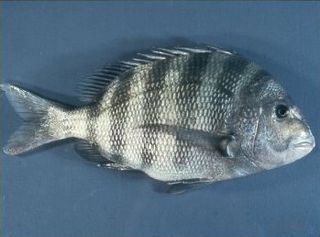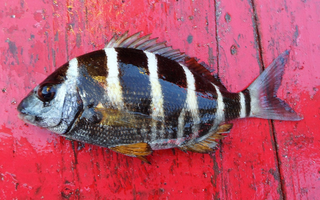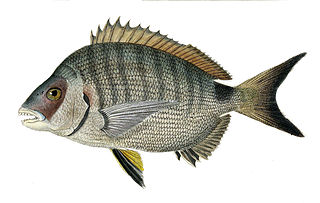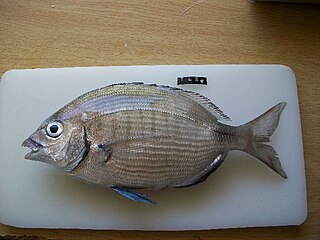
Sparidae is a family of ray-finned fishes belonging to the order Spariformes, the seabreams and porgies, although they were traditionally classified in the order Perciformes. They are found in shallow temperate and tropical waters around the world and are demersal carnivores.

The red porgy, also known as the common seabream or Couch's bream, is a species of marine ray-finned fish in the family Sparidae. It is found in shallow waters on either side of the Atlantic Ocean, being present on the western coast of Europe and the Mediterranean Sea as well as the eastern coasts of North and South America and the Caribbean Sea. It feeds on or near the seabed and most individuals start life as females and later change sex to males.

Pagrus is a genus of marine ray-finned fishes belonging to the family Sparidae, which includes the seabreams and porgies. These fishes are found in the Western Pacific Ocean, Atlantic Ocean and Mediterranean Sea. They are esteemed food fishes which are targeted by commercial fisheries and are grown in aquaculture.

Arcachon Basin or alternatively Arcachon Bay is a bay of the Atlantic Ocean on the southwest coast of France, situated in Pays de Buch between the Côte d'Argent and the Côte des Landes, in the region of Aquitaine. The bay covers an area of 150 square kilometres (60 sq mi) at high tide and 40 km2 (15 sq mi) at low tide. Some of its geological features are natural preservation areas.

The spottail pinfish is an ocean-going species of fish in the family Sparidae. It is also known as the spottail seabream or spottail pinkish porgy. Along with other members of their family, spottail pinfish are occasionally eaten and considered by some to be a panfish.

The jolthead porgy is an ocean-going species of fish in the family Sparidae. In Bermuda, it is known as the blue bone porgy, in the United States, it is also known by the Spanish name bojanado, in Jamaica, it is one of the species known by the name, porgi grunt.

Diplodus sargus, the sargo, common white seabream, or white seabream is a species of marine ray-finned fish belonging to the family Sparidae, which includes the seabreams and porgies. This fish is found in the eastern Atlantic Ocean and in the Mediterranean Sea. It is a target species for commercial fisheries and is grown in aquaculture. D. sargussensu lato was formerly thought to be a widespread species in the eastern Atlantic and western Indian Oceans but the taxa outside of D, sargussensu stricto are now recognised as valid species and are part of the D. sargus species complex.

Diplodus is a genus of marine ray-finned fish belonging the family Sparidae, which includes the seabreams and porgies. These fishes are found in the Atlantic Ocean, the Mediterranean Sea and the western Indian Ocean.

Archosargus is a genus of marine ray-finned fishes belonging to the family Sparidae, the sea breams and porgies. These fishes occur in the Western Atlantic and Eastern Pacific Oceans.

Diplodus vulgaris, the common two-banded sea bream, is a species of marine ray-finned fish belonging to the family Sparidae, which includes the seabreams and porgies. This species is found in the northeastern Atlantic Ocean and the Mediterranean. It is an important species for fisheries and is grown in aquaculture.

Rhabdosargus sarba, also known as the goldlined seabream, silver bream, tarwhine, or yellowfin bream, is a species of marine ray-finned fish belonging to the family Sparidae, which includes the seabreams and porgies. This fish has a wide Indo-Pacific distribution.

Acanthopagrus is a genus of marine ray-finned fishes belonging to the family Sparidae, the sea breams and porgies. The fish in this genus are found in the Indian and western Pacific Oceans.

Rhabdosargus is a genus of ray-finned fish belonging to the family Sparidae, which includes the seabreams and porgies. These fishes are found in the southeastern Atlantic Ocean and throughout the Indo-West Pacific, although mainly in the western Indian Ocean.

The banded seabream is a species of marine ray-finned fish belonging to the family Sparidae, which includes the seabreams and porgies. This species is endemic to Cape Verde in the eastern Atlantic Ocean.

The St. Helena white seabream is a species of marine ray-finned fish belonging to the family Sparidae, which includes the seabreams and porgies. This fish is endemic to the island of Saint Helena in the southern Atlantic.

Diplodus hottentotus, the zebra, is a species of marine ray-finned fish belonging to the family Sparidae, which includes the seabreams and porgies. This fish is found in the Western Indian Ocean off Southern Africa.

Diplodus capensis, the Cape white seabream or blacktail seabream, is a species of marine ray-finned fish belonging to the family Sparidae, which includes the seabreams and porgies. This fish is found around the coasts of Southern Africa.

Rhabdosargus globiceps, the white stumpnose or go-home fish, is a species of marine ray-finned fish belonging to the family Sparidae, which includes the seabreams and porgies. This fish is endemic to the waters off Southern Africa.

Rhabdosargus haffara, the haffara seabream or Haffara stumpnose, is a species of marine ray-finned fish belonging to the family Sparidae, which includes the seabreams and porgies. This fish is found in the northwestern Indian Ocean.
Rhabdosargus niger, the blackish stumpnose, is a species of marine ray-finned fish belonging to the family Sparidae, which includes the seabreams and porgies. This fish is known only from the western coast of Kalimantan in Indonesia.





















